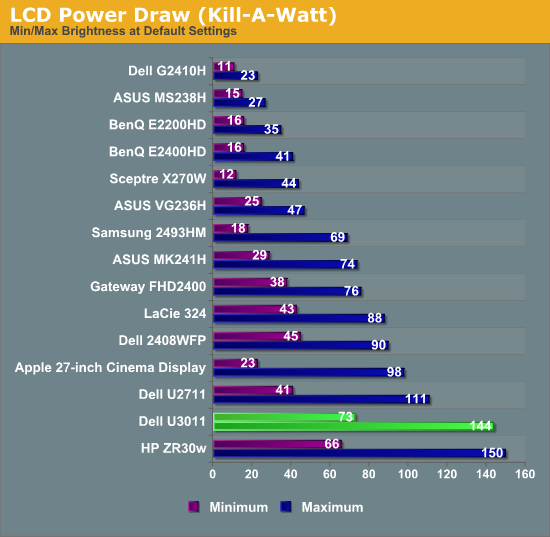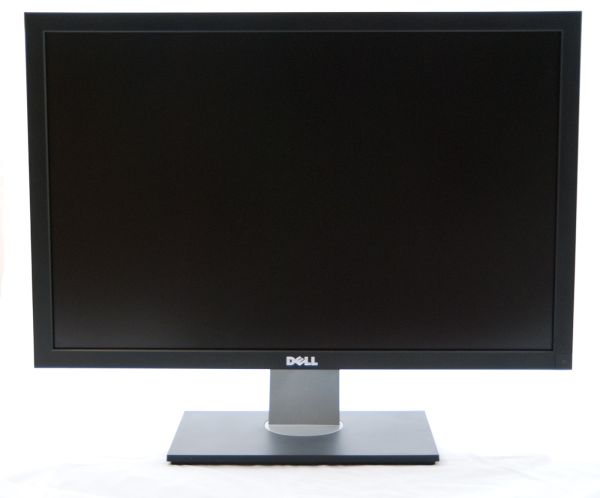Dell U3011 Review: Dell's New 30-inch Flagship
by Brian Klug on January 13, 2011 9:17 PM ESTPower Consumption
The 30-inch category of displays have always been power hungry, and the U3011 is no exception. Laws of physics still apply here, and when it comes down to it, there's just a lot of area to fill with photons. The U3011 specifications note that power use of 250 watts is maximum, 110 is typical, and standby is around 1 watt.

At maximum brightness, the U3011 draws 144 watts. At minimum, 73. That's just slightly below the ZR30w, but not really enough to make it notably better or worse.
We don't measure it directly, but subjectively the U3011 feels surprisingly cool. There isn't a ton of heat which seems to come out the top grilles, nor a ton of heat coming out the front (unlike my BenQ FP241w monitor array which seems to noticeably warm my face).
Conclusions and Final Thoughts
The U3011 is an all around good performer, though I find myself wishing that contrast and Delta-E were just a bit better so it was an unequivocal winner in all the right areas. That said, it does have a number of advantages over the HP ZR30w, namely an OSD, a wealth of input options, and audio pass through. Where the HP ZR30w bests the U3011 is with its excellent display arm which feels subjectively sturdier and beefier, and its slightly better color performance and input latency. Heck, maybe there's something to be said for not having that display controller SoC.
If accessory inputs like an extra DVI and HDMI port are what matters (not to mention the option of having 5.1 audio out), the U3011 is the better choice. As an all around desktop display, the ZR30w edges out in my mind purely because of the slightly better display performance and build quality - it feels solid and just seems to have a much beefier display arm. It's a tossup that ultimately comes down to what features are really most important, and price. Right now, even price is a tossup, as the two are priced within $10 of each other on Amazon. Personally, having HDMI with audio pass through and all the scaling options makes the U3011 the better pick, but again that's just my take. Now the question is: who will be first to market with a 120 Hz 30-incher?











123 Comments
View All Comments
CSMR - Friday, January 14, 2011 - link
High pixel pitch will increase legibility of text, and everything vector-based.Guspaz - Friday, January 14, 2011 - link
In terms of pricing from Dell themselves, I'm seeing the U2711 at $849 CAD, and the U3011 at $1599 CAD. Considering they offer the same class of resolution (2560xSomething, although I'd rather see 2560x1600 on the U2711, at least it's still 2560), a similar set of inputs, and the U2711 is a bit better in calibrated colour accuracy (and way better uncalibrated), it really looks to me like the U2711 is the better buy.Sabresiberian - Friday, January 14, 2011 - link
Same class of resolution? The pixel pitch on the 30" is .2505, the pixel pitch on the 27" is .233 - clearly a much tighter image. They aren't in the same resolution class by a long shot.I agree, I'd love to see a 2560x1600 .233 pixel pitch monitor - or better yet, a full 30",16:10 monitor with that pixel pitch. That would make my current 3-way conundrum - buy a U2711, a ZR30w, or wait for that 120Hz 30" monitor, a much easier decision. Especially if it were 120Hz. The dang 16:9 ratio of the U2711 is what makes it such a tough choice; I just don't want to support the industry using that format in any way - but I do want to throw in my vote for small pixel pitch as well as use a monitor with as fine a screen as I can get.
;)
Iketh - Saturday, January 15, 2011 - link
How are you supposed to get 2560x1600 .233 pitch on a 30" screen? That's physically impossible. May want to read up on what pixel pitch is, and the reason why a smaller screen with the same resolution will always have a lower pitch.adiposity - Sunday, January 16, 2011 - link
If you read his comment carefully, he didn't say that. He said either:a 2560x1600 @.233 pitch
or
a 30" 16:10 monitor with .233 pitch
Hrel - Friday, January 14, 2011 - link
Dang, look at those response times! No guitar hero being played on this thing.AnnonymousCoward - Saturday, January 15, 2011 - link
7ms GTG. How often does a PS3 refresh frames--24fps? That's 42ms.I'll give you the benefit of the doubt and assume you only play Guitar Hero on PC emulators with a CRT @ >140Hz.
aguilpa1 - Friday, January 14, 2011 - link
the OSD is the same as the Alienware 23" 120Hz LCD's, even copied the light up touch panel but went with blue instead of red. They may have considered the 120Hz option. Also the Optx 2310's have panel overdrive which mitigates the response time and removes the lag. I noticed on some reviews of the 2310's they are not doing this and reporting the panels have to much lag especially in 3D mode but if you set the panels to game mode and enable overdrive the visible lag problem goes away. I did that to all three of mine.MeanBruce - Friday, January 14, 2011 - link
Dude, It's the same OSD because Dell bought Alienware a few years back. Same design group. Pretty sure all the 24in panels Dell/Alienware are assembled in the same little factory in Meheeco.aguilpa1 - Friday, January 14, 2011 - link
yup I know this, I was just saying, when I ordered my three 2310's they were from Dell. On a panel that is supposed to be their flagship they should have also stole the quality of design, the 120Hz, the overdrive engine and not just the OSD from the 2310's.